Time to Finish Planting the Garden
It’s Memorial Day Weekend and it’s time to finish planting the vegetable garden. All the veggies that are sensitive to the cold can finally be planted. That includes tomatoes, eggplants, summer and winter squashes, beans, basil, cucumbers, melons and more. The soil gets prepared the same way that it did for the hardy vegetables.

First, I add my amendments; Azomite powder, organic alfalfa meal, kelp meal and compost or aged manure. I sprinkle the first three with a dusting on top then put on a good inch or two of compost or manure. Then I use a broad fork or pitchfork to gently loosen the soil, raking it flat at the end.
I never rototill or otherwise turn the soil. In nature, the leaves fall to the ground and decompose from the top down. This allows the worms and all the micro-organisms to keep their structures and pathways intact. When the soil is turned, it’s like a tornado hit this community and there are many casualties. It also exposes lots of weed seeds to the air for germination. A better garden and a bigger harvest occurs when the soil isn’t disturbed.
Summer and winter squashes, beans, basil, and cucumbers can be planted from seed right into the soil. You can hold off on the compost or aged manure to place on top of the seeds.

The squashes and the pole beans can be planted in circles resembling a volcano. Make a hill with a depression at the top to catch the rain. These hills should be about two feet in diameter and one to two feet apart. Place eight to ten squash seeds in each hill, planning to thin to three once they germinate. The pole beans can be planted more thickly, perhaps every inch or two. Cover with the compost.
The squashes will sprawl over the ground so be sure to plant them in a place that they can grow out from. The beans will need supports to climb.

Make a teepee out of six or eight bamboo stakes, tying it at the top. You will have to start the plants up the poles, but once started, they will continue growing up.
Cucumbers can be planted in two rows down the middle of a bed.

They will need a trellis or a fence on which to climb. You could put a couple of garden stakes at the edge of the bed and hang some chicken wire from a pole at the top. Planting nasturtiums right in the bed with the cukes helps to keep the cucumber beetle away. You could also buy some cucumber plants to get started and put in some seeds for a later crop.
Tomatoes, melons and eggplants should be purchased as young seedlings for planting.

Tomatoes are tricky. They used to be easy, but the blight has become almost universal and a big problem. They need to be fed very well to keep them strong. Give them lots of aged manure, kelp meal, worm castings and, ideally, some micorrhizial innoculant. If you are adventurous, you can also give them a fish head. Make sure that you bury it very deep so that it won’t attract animals.
Plant the tomatoes very deeply. They can develop roots along their stems so put them far down. Place the worm castings, kelp meal and micorrhizial innoculant right next to the roots. Take off any lower leaves and put some kind of tomato cage around them. It’s a good idea to tie them right up to the cage with muslin strips and put down a bit of mulch under them. The rain brings the blight up from the soil, splashing it on bottom leaves first and then up the plant. Any way that this can be avoided is good.
Another great thing about this particular Memorial Day Weekend is that the Moon is in the tremendously fertile sign of Cancer both Saturday and Sunday. So it is truly time to get planting!
I am teaching workshops from my home this summer. Visit http://celestelongacre.com/invitation-come-celestes-farm-learn/ for the details.







